Comprehensive Guide to Email Copywriting: Get Paid for Something You Already Know How to Write
(and then consistently!) make great money as a writer is to
learn the secret to writing effective marketing emails.
Welcome to email copywriting!
Companies use emails for EVERYTHING …
To build relationships with prospects …
To welcome new customers …
To ensure they remain happy and satisfied …
To introduce exciting deals …
To deliver useful and valuable information …
And many more ways, as you’ll discover in this guide.
Plus,many companies send one, two, three emails per day to various lists. And rarely is any one email repeated. That’s a lot of emails!
Which is why once a company finds an email writer they like — they KEEP them and PAY them very well.
Mainly because — emails work!
In fact, emails are among the most PROFITABLE copy projects that businesses of all shapes and sizes can use today.
Industry statistics show emails, on average, generate a 38-to-1 Return on Investment. That means for every dollar spent on email marketing, a business gets $38 in return.
Imagine going to a slot machine in a casino knowing that when you slide your dollar in — $38 will come back to you …
Each and every time.
You’d be playing that machine all day long, right?!
Other recent studies gauge the return even higher — $45 for every $1 spent …
And depending on the kind of company — the returns can be far higher: $50 … $68 … even $90!
Those returns make sense when you think about the frequency you check your email …
A recent study from HubSpot found that 99% of consumers reported checking their email every day. More than half admitted to checking it more than TEN TIMES per day!
Not only that, but global email marketing revenue is estimated to reach $17.9 billion by 2027.
Which is why it’s no surprise that companies are sending more emails more often …
According to Statista, over 347 billion emails were sent per day in 2023. And that number is expected to exceed 392 billion by 2026.
The opportunity for writers in the email copywriting specialty is HUGE.
That’s why we’ve put together this guide to email copywriting … so you can take full advantage of this “hidden in plain sight” writng opportunity.
In this guide, we’ll cover the fundamentals of email copywriting — what it is, top projects that marketers are looking for, tips on how to write them, and what you can expect to earn as an email copywriter.
Let’s dive in!
What Is Email Copywriting?
Email copywriting is the process of writing emails that get current or prospective customers to take action. Depending on your marketing goals, that action could be clicking through to an article, signing up for a webinar, making a purchase, or something else.
Whatever the intended action is, your role as an email copywriter is to get the reader to say yes and click on the appropriate link in your email.
In general, there are two main types of email copywriting: inbound and outbound.
Let’s take a look at each:
Inbound Email Copywriting
With inbound email copywriting, readers have come to you by opting into your (or your client's) email list or interacting with your company in some way.
They may have downloaded a special report, subscribed to a newsletter, made a purchase, or requested additional information. They want to hear more.
So this form of email writing is all about developing an ongoing relationship with customers or prospects. It generally involves sending regular newsletters, product updates, or articles that are useful to your audience and lets them know you appreciate them.
It also serves to maintain a steady line of communication — keeping your brand at the forefront of their minds, and subtly prompting them to engage further with your products or services.
Outbound Email Copywriting
Outbound email copywriting is about getting in front of your ideal customers in order to establish a relationship and start a conversation. Think of outbound email like cold calling. You’re reaching out to prospects who haven’t yet opted to communicate with you.
The right outbound emails can generate fantastic results. Still, since you’re sending unsolicited emails, you’ll want to ensure you’ve done your research and provide value to your prospective customer from the get-go.
If you’re interested in more details on how email copywriting works, check out our free webinar Today’s Unexpected Opportunities for Email Writers.
Is Email Copywriting Hard?
In short — no! Email copywriting is one of the easiest areas of copywriting to break into (and start making good money with) for a few different reasons:
- Emails are short — an average email is only 175–500 words long, and typically no more than 800 words max.
- Minimal in-depth research is needed — you might highlight one or two pieces of factual information in an email, but there’s simply not enough space to warrant extensive research.
- Emails use proven writing formulas — email copywriters use specific templates that are shown to convert the best.
- There's a wealth of examples to learn from — with so many companies using email, you can draw from countless great examples for inspiration and learning.
- Email is measurable — you receive ongoing feedback on your email campaigns through response rates and other defined metrics. This helps you test, tweak, and improve your copy over time.
We could go on …
But as you can see, email copywriting is an easy skill to learn, with ample resources to draw from when needed.
In fact, six-figure copywriter Guillermo Rubio, who we affectionately call “G” at AWAI, has often said that if he had to start all over again from scratch — he would start by writing emails.
You see, when G started his writing career over two decades ago, the options were more limited. So he began by learning how to write long-form sales letters by taking AWAI’s The Accelerated Program for Seven-Figure Copywriting.
But with the variety of well-paid writing projects available now, G says that instead of focusing on long-form sales letters first, he’d spend his time getting as good as possible at writing emails.
He explains, “Email writing is a skill that can be learned quickly. It took me a good chunk of time to get to the point where I could write a decent sales letter, from start to finish. But an email is just a few hundred words. It doesn’t require weeks of research. No having to spend days mulling over possible Big Ideas or anything like that.”
While sales letters may be among the highest-paying projects out there, they have a steeper learning curve and come with the pressure to perform and generate sales immediately.
Writing emails is a much simpler path …
With email, it’s far easier to get your foot in the door with a client and get paid much faster. It’s a low-risk way for a company to “test” a writer out. They really don’t have much to lose to hire you to write a couple of emails for them.
There are additional reasons to start your writing career by becoming an email copywriter as G suggests. Here they are …

Why Should I Become an Email Copywriter?
Email is more than just a hot, in-demand skill that can be learned quickly. There are many other excellent reasons to become an email copywriter, such as:
- Emails are easy and fun to write
- Practically every business in the world sends emails
- Great for new writers
- Unlimited income potential
- Makes you a better writer
Let’s take a closer look at these five reasons why you should take advantage of the huge email copywriting opportunity …
1. Emails Are Easy and Fun to Write
As we mentioned, most emails are less than 800 words and they typically follow a formulaic structure.
This makes them easy to learn and quick to write. Most email projects can be finished up in two to three hours, max. And once you have some experience with a client and know their products and voice well, you can often complete a simple email in under an hour.
This fast-finish aspect of email writing means that even if you’re a part-time writer or juggling your writing career as a side hustle, you can still comfortably take on email clients.
Email writing is also a lot of fun. Emails are typically written in a fairly casual, conversational style — the same as you would write to a friend. So, you don’t have to worry about learning a complicated new style of writing.
2. Practically EVERY Business in the World Sends Emails
Another fun part of email copywriting is the fact you can write about almost anything. Nearly all companies send email — so if there’s a subject you want to write about, you’ll almost certainly be able to find clients who are a perfect fit for your area of expertise.
Pets … interior design … gardening … weight training … photography … technology — you name it! There are clients everywhere who need your email copywriting services.
Every serious business in practically every niche imaginable is sending out emails to welcome new customers … launch new products or services … maintain a relationship … and more.
That means you can write about whatever your heart desires — and best of all, you can do it while still making a solid six-figure income.
3. Great for New Writers
One of the best things about being an email copywriter is the fact you don’t need a ton of experience to get started.
Most clients don’t care how long you’ve been writing, or for whom. What they really value is experience in their niche. Ideally, they want a writer who can step in immediately and hit the ground running, without having to be trained in their business.
That means you can draw on any of your previous life experiences to get your foot in the door with email copywriting — from work experience, to hobbies and interests, to topics you simply enjoy reading about and researching.
In addition, emails are an easy “test” project for a potential client. A company doesn’t have to take a big risk or expense by hiring you for a short email series — compared to longer, more complex projects like sales letters.
And … if you do a good job writing an email project, it can quickly (and easily) lead to more work and bigger projects LIKE sales letters, landing pages, and more.
4. Unlimited Income Potential
Emails are a naturally recurring project. Many businesses send emails to their customers and prospects every day. So, if a test email project goes well, there’s a good chance a business will sign you up as their ongoing email writer.
Repeat contracts or retainer arrangements for email writing are common — and consistent, ongoing work like this helps you create a stable income flow as a writer.
And speaking of money …
Email pays very well — especially when you consider how emails are short writing projects that can be completed in very little time. (You can take on as many email clients as you’d like to meet your financial and lifestyle goals.)
A basic rate for a beginner to charge is around $100 to $250 per email. More experienced writers can charge over $500 — with sales and other specialized emails running over $1,000 or $2,000 each. (We’ll take a more in-depth look at how much email copywriters make in another section.)
Not to mention … most companies also need many different types of emails. We’ll describe all these types in the next section, but for now know this means you might be writing multiple email projects for one client — which increases your income and reduces your need to find new clients.
5. Email Writing Makes You a Better Writer
Many email copywriters find that email writing has made them better writers. The main reason why is that email forces you to improve your clarity and be concise.
A subject line is only around 40-60 characters. That’s characters, not words.
Then, the email body copy is normally 175-500 words long (typically no more than 800 words).
So, in that short space, you’ve got to:
- Get someone’s attention,
- Get them interested in what you have to say, and
- Get them to click on a link in the email.
It really forces you to streamline your writing down to the critical “essentials” of persuasion — leaving out everything else that doesn’t work.
This eventually transfers over into your other writing … whether it’s writing blog posts, long-form sales letters, paid ads, or other projects.
What Types of Email Can I Write?
As an email copywriter, you’ll have an opportunity to write a wide range of emails that serve various purposes. For example:
- Welcome Sequences
- Post-Purchase Onboarding Sequences
- Content Emails/Advertorials/E-newsletters
- Email Funnels
- Direct Sales Emails
- Upsell Emails
- Cart Abandonment Emails
All these email types are vital for the businesses that use them, and they require your specialized email copywriting skills.
And remember, you can charge separately for each of these different emails.
Here’s a more detailed description of each of these in-demand email types …
- Welcome Sequences — You would get these emails if you signed up to receive emails from a company for the first time, such as joining their newsletter. Welcome emails tell a reader more about the company, what to expect as an email subscriber, and the benefits of being on their mailing list.
- Post-Purchase Onboarding Sequences — Similar to a welcome series, post-purchase sequences are sent after a new or existing customer makes a purchase. These would thank the reader for their purchase and provide some helpful details or instructions about their new product or service.
- Content Emails/Advertorials/E-newsletters — Ongoing, information-based emails can take many forms, but they’re all meant to keep in touch with a company’s email subscribers and provide value in some way. They can be sent daily, weekly, or monthly, depending on a company’s objectives and budget.
- Email Funnels — These are specific email series designed to support a company’s overall sales process. For example, a new prospect might sign up to receive a free lead magnet from a company, then get a welcome email sequence that also encourages them to check out one or more paid products or services.
- Direct Sales Emails — Sales emails are meant to promote certain products, services, or offers. For instance, you might send out a series of direct sales emails to promote a Black Friday or holiday discount, a new product launch, or a flash sale. Their purpose is clear: to get the reader to buy.
- Upsell Emails — This type of email encourages a buyer to make an additional, higher-priced purchase. For example, say you sign up for the free version of an app. Afterwards, a company may follow up by sending you an email series encouraging you to sign up for the paid version of the app so you can get more functions and benefits. This would be an upsell email series.
- Cart Abandonment Emails — According to Findstack, seven in every 10 shoppers abandon online shopping carts before completion. Cart abandonment emails encourage prospects to complete their purchase. And it seems we need a few reminders — three cart abandonment emails result in 70% more completed orders than just one.
Email Copywriting Examples
Want to see some emails in action? We gathered examples from a few different companies — in both the Business-to-Consumer (B2C) and Business-to-Business (B2B) industries.
We also wanted to share emails that were NOT written by superstar, A-list copywriters, simply to show that all types of companies use email on a regular basis — both big and small — and they can all use your email copywriting services.
1. Content Email from Adam Enfroy @ Blog Growth Engine
Blog Growth Engine, run by Adam Enfroy, is an online program on how to build a blog. The email example below is one of Adam’s ongoing informational emails that he sends to his list weekly.
You can see his emails are typically quite short, and they usually share his most recent YouTube video:
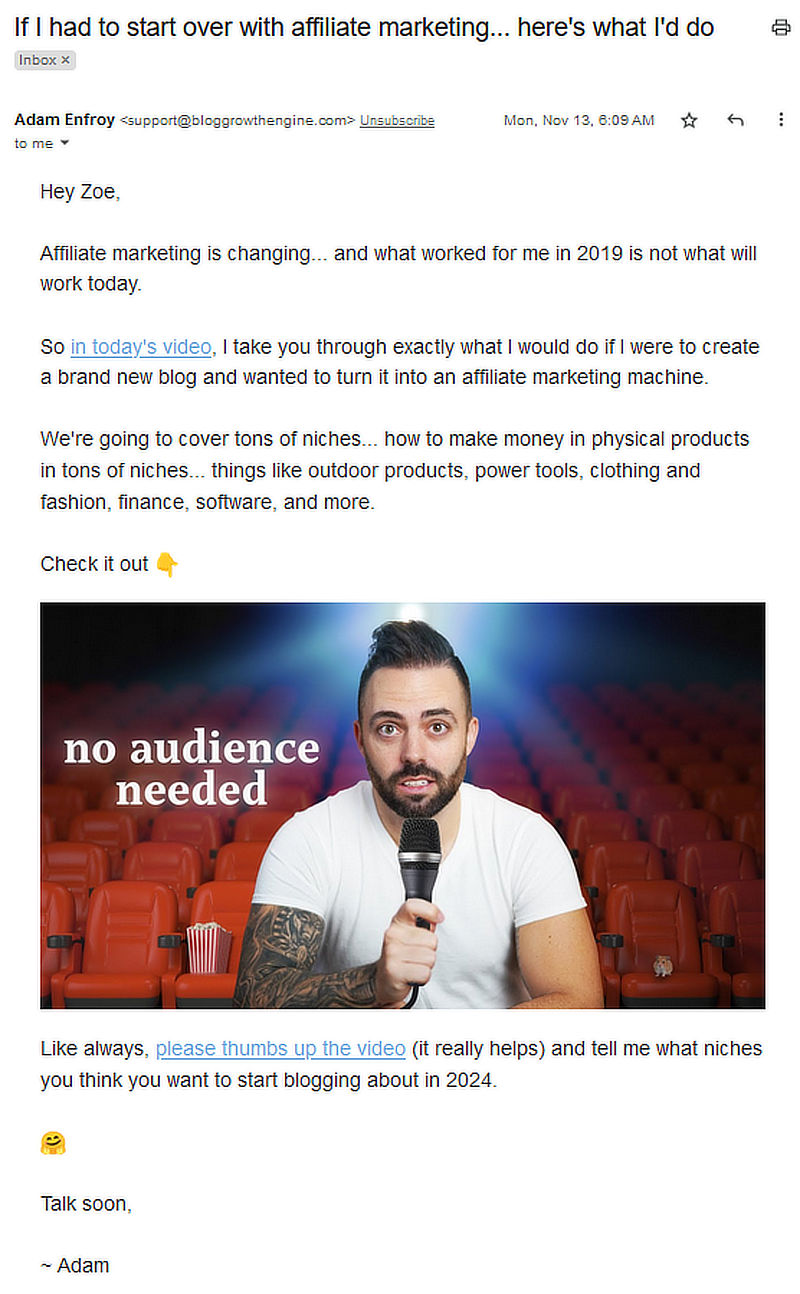
Adam’s email clocks in at a brief 114 words, including his signature.
But it covers a lot …
It starts with an interesting hook that draws the reader in …
Then it clearly describes what to expect in his video and how it would benefit the reader …
And it provides three separate links to the video (the picture itself also links to the video).
These few targeted details would be more than enough to entice someone interested in affiliate marketing to click on his video.
Now, do you think you could write an email like this?
You almost certainly could — and you could likely do it pretty quickly, too.
Gathering some useful information and presenting it clearly is really all it takes to write successful content emails.
2. Local Business Email Newsletter from Room + Pillar Spa
An email newsletter, or e-newsletter, is simply a longer informational email that gets sent to subscribers periodically.
The example here is from a local business in Kelowna, British Columbia — The Room + Pillar Spa. It’s a small business that sends an e-newsletter to their list once a month.
It starts with a short, seasonal greeting and highlights one of their services (body wraps):
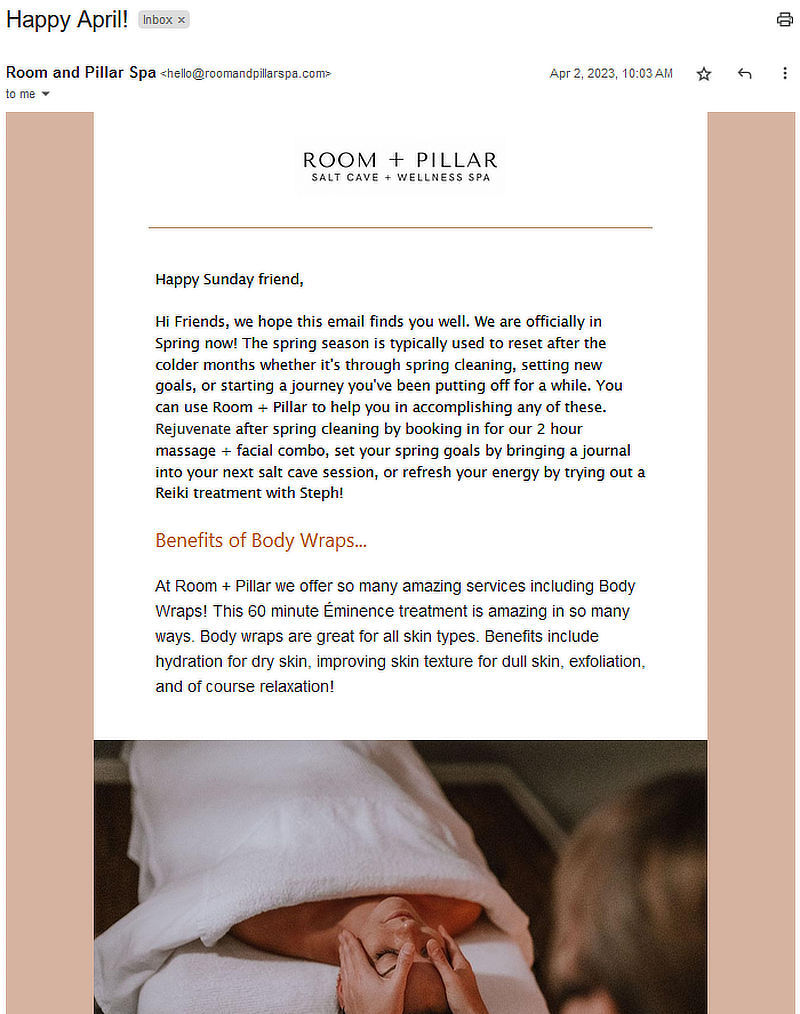
Then the email goes on to describe a featured product of the month and upcoming events:
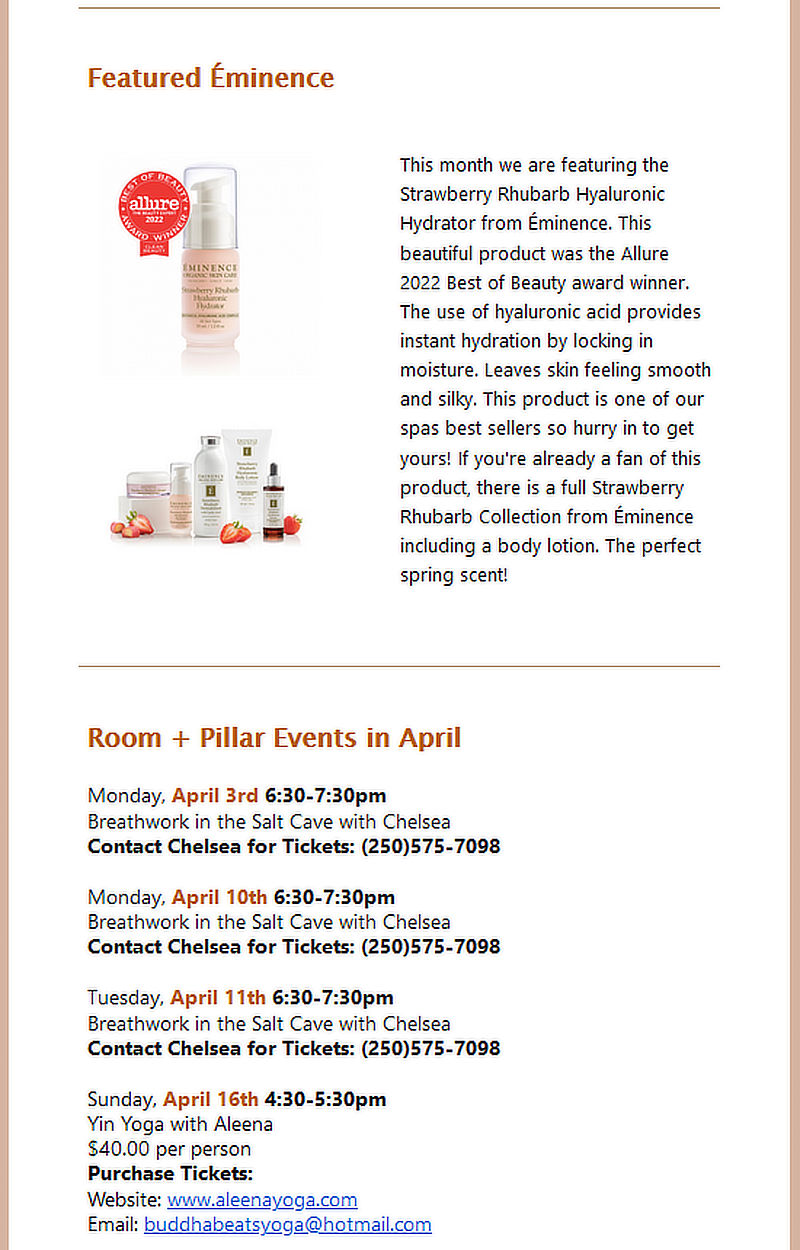
The last section of the email shares a featured service for the month with a clear call-to-action and contact details:

Then, the email closes with a friendly sign-off and a P.S. that offers the reader a discount on their next service just for reading their email:
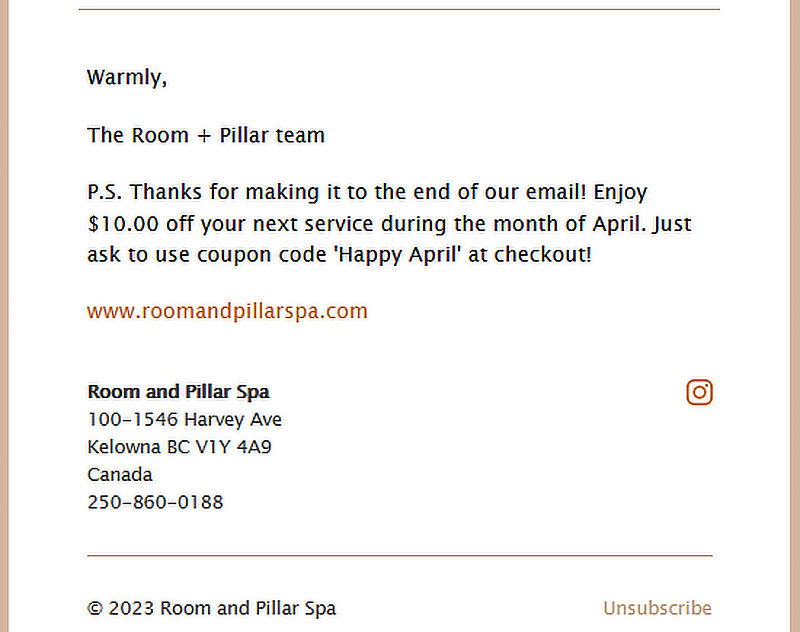
This e-newsletter totals around 530 words.
But similar to Adam Enfroy’s example, notice how much information the writer actually included in one short e-newsletter.
It was friendly, helpful, and relevant to the reader. It didn’t waste the reader’s time.
Yet, it also highlighted many of their products and services with enticing details and clear calls-to-action.
Again, do you see how easy this would be to write?
And keep in mind, your job as an email writer would typically be just that — writing. Your client is usually responsible for entering the email in their email management system, adding images, and doing the final formatting and scheduling.
Of course, if you’re experienced with email management, you can also offer this as a service for an additional fee.
But if this is not your strength or interest, simply let your client know that you will only be providing the copy, which is all that most companies would expect.
3. Direct Sales Email from Marley Rose Harris
Marley Rose Harris is a mindset and business coach, and this is an email she sent for a Black Friday promotion for two of her main group coaching programs.
The promotion is stated clearly in the subject line, and the body of the email wastes no time (or words) before getting straight into the details of the offer:
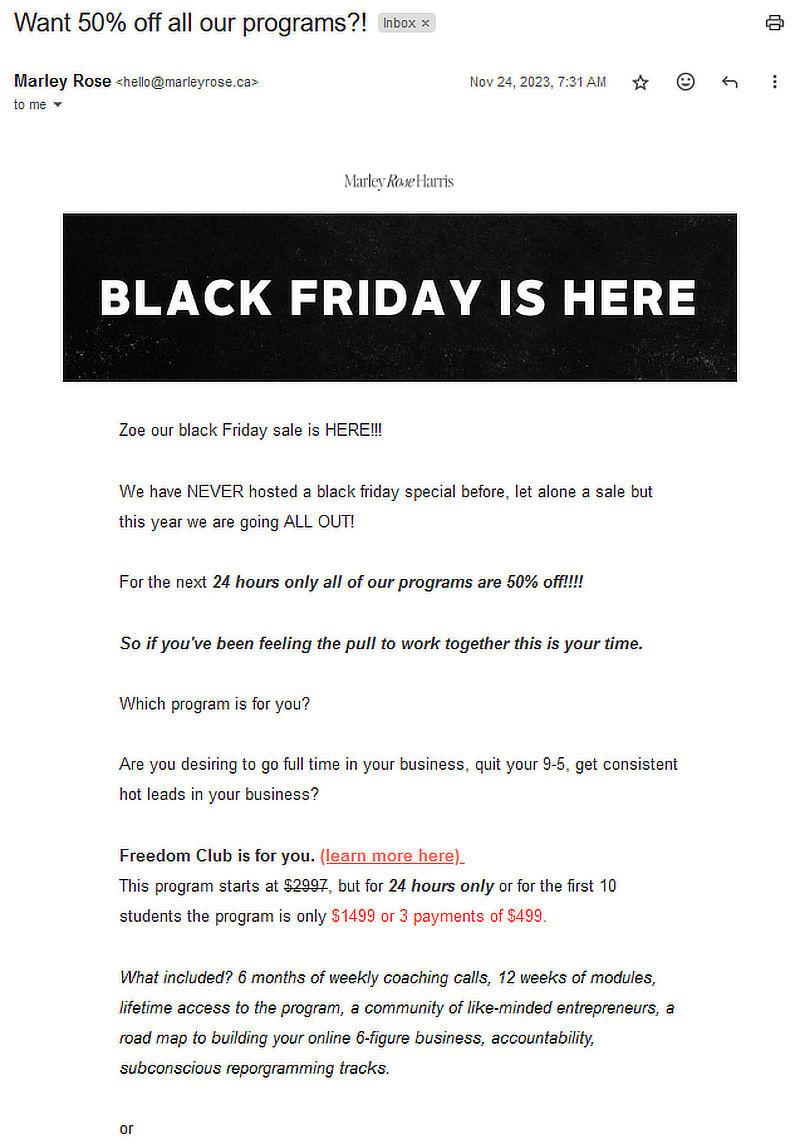
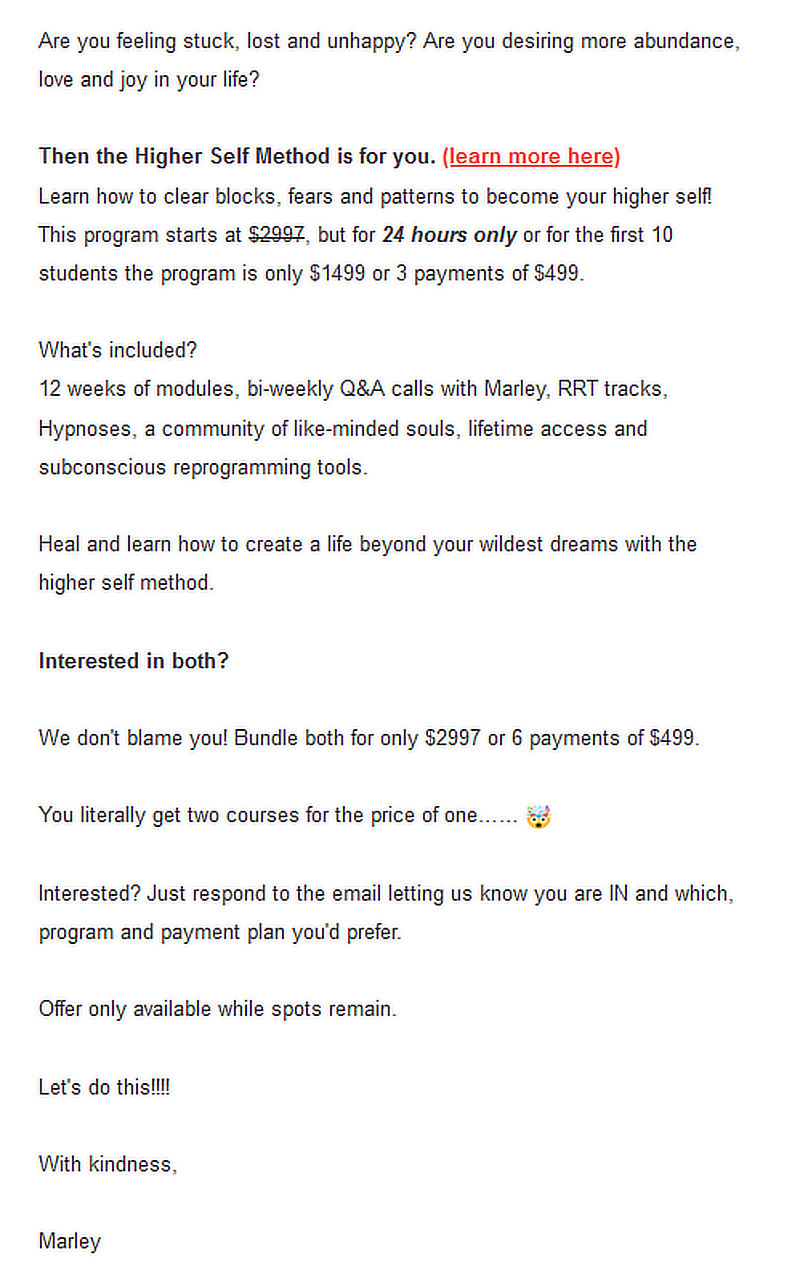
Her email clearly describes her offer, but it also provides some helpful guidance on which of her two main programs might be best for the reader, depending on their personal goals.
It also shares the benefits of each program, as well as what’s included, the discounted prices and payment details, and when the offer expires.
And this is all done in under 320 words.
Are you seeing a pattern here? All the email examples we’ve looked at are short, simple, and to the point — which is exactly what makes an effective email.
4. Post-Purchase Upsell Email from PDF Complete
PDF Complete is a PDF editor that helps businesses create, modify, and export documents. The solution allows users to convert documents from various formats into PDF, add notes or comments, underline text, and merge documents into a single PDF.
The following email is sent to people who own the ‘basic’ PDF Complete software product.
The subject line of the email was: “Upgrade to PDF Complete Office Edition today and save over 60%,” and the message inside directly correlates with that theme.
The email starts by thanking the reader for being a loyal customer and then points out some benefits of upgrading to the Office Edition today:
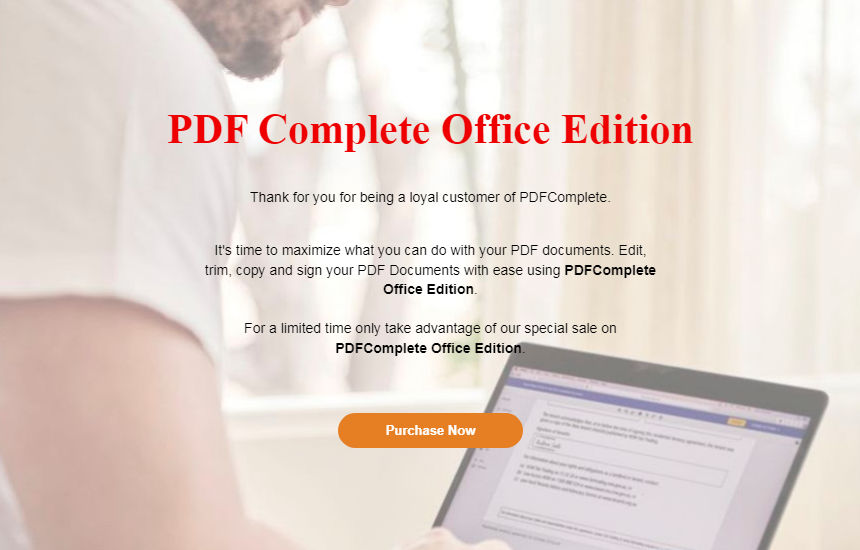
This part also includes clear call-to-action text on an attention-getting orange button.
After that, the email continues with reviews of the PDF Complete Office Edition product. These proof points from reliable, well-known names in that industry add to the brief yet persuasive message of the email:
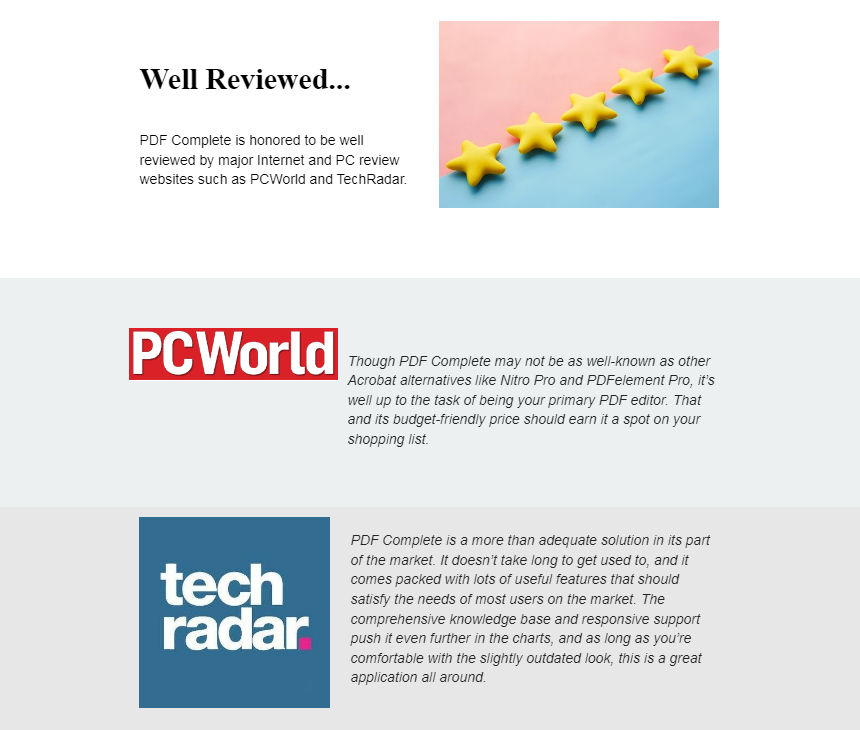
And the email concludes by including another opportunity to purchase via the “Purchase Now” button and an email address for more information:
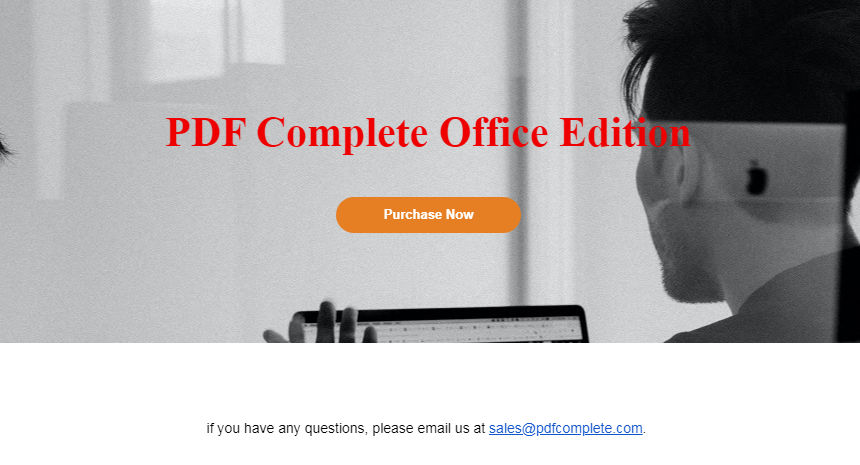
In just 211 words, this email made an upsell offer, explained some benefits of the upgraded product option, and provided reviews about the product from well-known names in the tech world. This email of offer plus proof accomplished a lot in a clear, concise message!
Email Copywriting Tips
You’ve discovered what email copywriting consists of, different types of email projects you might work on, and the massive benefits of learning this valuable skill.
However … what does it take to actually write great emails?
In this section, we share our top tips and techniques for mastering the art of email copywriting. These insights will help you create captivating, persuasive, and high-converting emails that your audience will not only open and read, but also act upon.
1. Set One Specific Goal Per Email
Your email copy should always work toward one goal so you don’t confuse or overwhelm your readers into inaction.
Sometimes the desired result will be making the sale. But often, the message will focus on building a relationship with the reader to move them through their buyer’s journey. Here are a few examples of actions you may want them to take:
- Download a resource.
- Read a blog post.
- Get a free trial.
- Open the next email.
2. Write to One Person
Don’t ever try to write an email aimed at a general audience. If you try writing to everyone, you end up speaking to no one.
Instead, always ask your client if they have a buyer persona of their ideal customer. This is a short document that outlines the type of person they want to reach with their marketing. For example, a buyer persona for a fitness coach might be a woman over 50 years old who is interested in losing weight and getting into better shape.
Then, you’d know to craft each email as if you’re writing to that one person by including information that’s relevant and interesting to them. Your message will be much more targeted, which makes it far more engaging and enjoyable to read.
3. Know Your Reader
Read your client’s buyer persona closely so you can get a good understanding of their ideal customer. And if your client doesn’t have a buyer persona — help them create one!
Do some research and find out what their customers’ main pain points are. What do they want most in life? What keeps them up at night? What problems do they need to solve?
Also, create a document to keep information you find during your research — from interesting facts and statistics, to current news items, to unique points of view from industry thought leaders. These are all great points to include in your future emails.
4. Craft Intriguing, Clickable Subject Lines
Your subject line is the single most crucial aspect of your email, making writing a good one your highest priority. Let’s face it … if your reader doesn’t open your email, then nothing else matters.
To learn how to write scroll-stopping subject lines, start by studying the subject lines of emails you receive. Which ones do you open, and why?
Keep a Swipe File of emails that caught your attention or were successful in getting you to act. Then use them as inspiration for future email copywriting campaigns.
Also, check out these 16 tips to write more effective email subject lines.
5. Don’t Forget Email Preview Text
The email preview is the snippet of text that appears along with your subject line. On a mobile device, it will appear right below it. On other devices, it will show right next to your subject line. This additional text is an excellent opportunity to further entice your reader to open the email. You can use it as a follow-up to your subject line to tell subscribers more about the content inside.
The company WeddingWire took this to heart, and increased its email click-through rates by 30% after improving its preview text.
6. Have an Element of Curiosity
Another important element to include in both your subject line and preview text is curiosity. That’s going to pique your reader’s interest and make them want to know more.
For instance, “He gets paid $1,324 every time he says this word,” has enough curiosity built-in that your reader wants to know more.

Image alt text: Woman working on laptop at home
7. Always Include a Call-to-Action (CTA)
Your call-to-action (CTA) is an invitation to your subscribers to take action; it provides a simple and clear direction so readers know what to do next.
Go back to the target objective of your email and use this to guide your CTA. Here are a few examples:
- Click here to read more.
- Keep an eye out for my next email tomorrow.
- Get 50% off today.
A good CTA improves conversion rates, but it also makes the reader’s life easier. You don’t want to leave them guessing, so make their next action step clear.
8. Consider a P.S.
Most subscribers won’t read your email word for word. However, over 90% of people read the P.S. — and they read it before the rest of the email!
Use your P.S. to capture your reader’s attention, summarize your message, and create urgency. Don’t think of it as an afterthought, but rather as a proven way to pack a punch at the end of your emails.
9. Know Your Client’s Brand
Emails are a fun opportunity to show off your brand’s personality. But before you start using emojis in your subject lines or GIFs in your body copy, it’s crucial to understand the brand you’re writing for.
Ask your clients for a style guide or examples of email copywriting they would like to emulate. You’ll quickly understand if they want to sound friendly and conversational, or more formal and serious.
10. Keep Your Emails Short and Concise
How many emails do you receive each day? Probably dozens.
Your readers are inundated, too, and they don’t have the time or attention to slog through long emails.
According to HubSpot, the ideal length of a sales email is between 50 and 125 words. So, keep your emails concise. Get to the point, and avoid wasting valuable email real estate on unimportant, flowery language.
11. Tell a Story
Yes, keep your emails brief, but don’t make them dry and dull.
When you can, incorporate storytelling. Our brains are hardwired to listen to stories. Plus, a well-told tale takes readers on an emotional adventure — it pulls them in on a sensory level.
Use short, compelling stories to entertain and inform readers. You’ll grab their attention, make your message more relatable, and improve conversions.
12. Master Persuasive Writing
Persuasive writing is the ability to influence your reader to think or feel a certain way. Inspire your readers to take action, and you’ll never worry about email copywriting success again.
Here’s the secret to persuasive writing success:
Don’t just tell readers what to think. Instead, successfully close the sale using these proven writing techniques.
Here are a few extra tips to give your email copy a persuasive boost:
- Ask, Why would my reader care?
- Solve a problem.
- Be specific.
- Use social proof, examples, and evidence.
13. Avoid Spam Filters
Spam trigger words are a quick way to get your emails blocked and sent straight to the recipient’s spam folder. Luckily, the key to landing in your subscriber’s inbox is a simple one: Choose your words carefully.
When in doubt, consult a list of spam trigger words and phrases to avoid.
If you focus on providing value to your reader, your emails are unlikely to land in spam. That means avoiding gimmicks, over-promising, or sensationalizing with all caps or multiple exclamation points.
14. Write Your Emails for Mobile
It’s no secret we live in a mobile-driven world. According to emailmonday, 75% of smartphone users check email on their phones — many of them first thing in the morning.
Consider how your subject line and preview text will look on a mobile device. While most desktops display 80 characters of a subject line, many mobile devices will cut your subject line off after only 30.
Writing shorter sentences and paragraphs is always a good idea, especially for mobile. Subheads and bullet points also help.
Finally, consider where your CTAs are sending readers — are these landing pages mobile-friendly, too?
15. Don’t Undervalue Email Marketing Newsletters
Promotional emails and sales funnels are crucial components of any successful marketing campaign. However, email newsletters are an excellent tool to keep your business top of mind — and inbox — for readers.
Send a good mix of exciting and educational content that shows your subscribers they’re valued and appreciated.
Also, commit to a regular publishing schedule and send your email newsletters consistently. If you struggle with ongoing content ideas, these email marketing newsletter tips will help.
16. Personalization Works
Want an easy way to increase your email open rates by 50%?
Add your reader’s name to the subject line.
Personalization is a simple way to cut through the clutter and capture your reader’s attention.
17. Tease — Don’t Give It All Away
When it’s time to write the body copy, your goal is to pull the reader in and get them to click on a link in your email. NOT get bogged down in dense or wordy messages.
So give your reader enough information to get them interested enough to click … but no more.
18. Get Comfortable with Marketing Metrics
There’s no way around it; if you want to measure how well your emails are working, you need to get comfortable with a few email marketing metrics.
It’s not as difficult as it may sound … your clients will be able to provide you with this information pulled from their email management system.
But being able to have these conversations with your clients adds to your professionalism and helps ensure your emails are hitting the mark.
Here are a few definitions to get you started:
- Email Open Rate: the percentage of email readers who open your email.
- Click-through Rate: the percentage of email readers who click on a link.
- Conversion Rate: the percentage of email readers who take a desired action.
- Unsubscribe Rate: the percentage of readers who unsubscribe from your list.
19. Always Edit Your Email Copywriting
Naturally, any piece of writing requires editing — nothing is perfect the first time around.
But when it comes to email copywriting, giving your copy a second (or third) look is vital. That’s because, unlike a blog post or a web page, you can’t easily edit an email blast. There’s no Undo button — no simple way to fix a typo or correct a mistake.
So, take the time to polish your email copy. Read it out loud and double-check all dates, prices, and links. Make sure it’s good and ready before you, or your clients, hit the Send button.
20. Take an Email Copywriting Course
These email copywriting tips are an excellent start to crafting high-converting email copy. However, if you want to jump-start your success, there’s simply no substitute for a comprehensive email copywriting course.
For some potential options, we’ve included a roundup of AWAI’s top email copywriting courses at the end of this guide.
How Much Do Email Copywriters Make?
We’ve already touched on the earning potential of email copywriting, but let’s take a closer look at average fees you can charge for different types of email …
- Regular content email: $100-$1,000 (depending on experience and complexity)
- Direct sales, upsell, or other promotional email: $250-$2,000
- E-newsletter: $800-$2,000
Remember, these rates are per email.
And a campaign rarely consists of a single email — you’ll typically be writing multiple emails in a specific campaign for a client. So you could be tasked with writing three, five, seven, or 10 emails in a series. Then, if the campaign goes well, the client may ask you to write additional campaigns after that.
It’s also common to arrange a retainer agreement to write ongoing emails or e-newsletters, which can be sent either daily, weekly, or monthly.
So, how does that add up for potential monthly or yearly income?
Well … say you’re new to email copywriting and your first client wants one email message for each day of the workweek. If you charge them a base rate of $100 per email, you’ll write 20 emails for your client each month and earn $2,000 total.
And how long will that take you? Even if you spend three hours on each email at the high end, that’s still only 60 hours of work for the month and $2,000 in income — which adds up to a yearly income of $24,000 (from one client).
Now, say you work full-time hours and decide to take on three clients in total — that raises your yearly writing income to $72,000. Not bad for short, easy projects!
And keep in mind … your writing speed will naturally increase over time, as will your fees. So, you’ll be able to write faster and for more money as your career progresses.
It doesn’t take long for email writing to add up to a sizeable income. This is why many established email copywriters make well over six-figures a year.
So how can you get started as a well-paid email copywriter? Read on …
How Do I Become an Email Copywriter?
Here are five action steps you can take right now to start getting this skill under your belt … and even potentially landing your first client.
- Sign up for email lists
- “Hardwire” the skills
- Practice, practice, practice
- Reach out to a potential client
- Get formal training
Let’s take a look at each of these action items in detail …
Open a new email account, such as Gmail or Yahoo!. Then find a few companies you like. They can be in markets you’re passionate or love learning about.
See if they offer a free newsletter, guide, or gift in exchange for you giving them your email address. Then go ahead and give them the email address you just opened.
In a few days’ time, you’ll have a smorgasbord of marketing emails you can start reading and studying.
After you’ve taken some time to read and study the emails you’re getting, it’s time to roll up your sleeves and get to work.
Pick a couple of the emails you found interesting, entertaining, or that made you want to click on whatever they were selling.
Now set aside some time to write them out by hand. This will help you “hardwire” the tone and pace of writing an effective marketing email into your brain and body.
After a few days of writing out emails by hand, try re-writing and improving some of the emails.
Give it your best shot and see if you can create an effective subject line. Try to enhance the body copy and give it more excitement and oomph.
And see if you can make the call-to-action even more irresistible.
Now that you’ve taken the time to re-write some emails, consider sending your newly created “samples” to the marketing manager of the company whose emails you rewrote.
They are a perfect client for you.
Let them know how much you like their products and services, and how you took the liberty of writing a few emails for one of their products. Invite them to look them over and then to talk further if they’re interested in getting some more help with their email marketing.
This part might be a little scary, but it could land you a client just like that!
One of the best ways to fast-track your email copywriting career is to get some formal training. You’ll be able to learn in-depth skills and knowledge from working email copywriters, so you can hit the ground running as a professional email writer as soon as you finish the course.
To help narrow down your choices, the next section details AWAI’s best-selling courses on different types of email copywriting.
Email Copywriting Courses
A professional email copywriting course gives you the opportunity to learn from industry experts and gain their hard-won practical skills and insider knowledge. A course also allows you to work on real-world projects that make excellent additions to your portfolio.
Here, we've compiled a list of AWAI’s top-rated email copywriting courses that can help you accelerate your journey to becoming a proficient email copywriter.
- How to Write High Impact Emails — This comprehensive course covers everything you need to know to create compelling and effective marketing emails, from crafting attention-grabbing subject lines, to writing engaging body copy, to creating persuasive calls-to-action. With real-life samples and exciting bonuses included, this program provides a hands-on approach to learning the art of email copywriting.
- Writing Email Copy for B2B Companies — Master B2B copywriter Steve Slaunwhite shares his expertise on how to excel in the world of B2B email copywriting. In this course, you'll learn how to write different types of B2B emails, identify potential clients, promote your services, develop a strong portfolio, and more. By the end of the program, you'll have the confidence and know-how to earn $800-$1,200 per day with your email copywriting skills.
- How to Write Engaging E-newsletters — Led by copywriting expert Pam Foster, this course teaches you the most popular types of e-newsletters, provides tips and strategies on creating them, and offers personal feedback on your writing. As e-newsletters are in high demand and offer the potential for steady, ongoing income, this program is a great opportunity to hone your skills and succeed in the industry.
- How to Earn Top-Level Fees Writing for the $5.4 Trillion Professional Services Market — Author and digital marketer Michael Katz teaches you how to tap into the highly profitable niche of writing email newsletters for professional service providers. With self-paced sessions, real-world examples, and valuable bonuses, you'll gain the practical skills to create engaging newsletters you can charge $1,200 to $2,000 each — month after month, and year after year.
- Over the Shoulder Training Guide for Digital Copywriters — Learn how to write three of the most sought-after digital copywriting projects in one course! This program shows you step-by-step processes for creating emails, blogs, and e-newsletters. You’ll also find out how to start landing your first clients and getting paid for these fun, repeating writing assignments.
- 10-Minute Workday — AWAI has collaborated with renowned email marketing expert Ben Settle to present this program on how to create your own email business — covering topics like market selection, product creation, list building, and crafting effective emails in just 10 minutes. This program offers a unique opportunity for writers who prefer the freedom of working independently rather than with clients.
- The AWAI Method™ for Becoming a Skilled, In-Demand Copywriter — If you want to learn how to write more than just emails, this is the program we recommend for all new writers! It takes you through the nuts and bolts of writing five of the top projects marketers are actively looking for — paid online ads, emails, blog posts, landing pages, and sales pages. By the end of the program, you'll have a portfolio of polished samples and the real-world knowledge to start landing clients right away.
It's Time to Make the Leap!
We hope this guide has shown you the boundless potential and exciting opportunities that await you in the world of email copywriting!
It’s one of the fastest and most straightforward paths to achieving your version of the writer's life …
Email copywriting is easy to learn, the projects command high fees, and there are a ton of potential clients who need your services.
So are you ready to give it a try?
You can start by practicing on your own, or by taking an email copywriting course to help speed up the process.
Either way, we're confident that your skills will grow quickly, and you'll soon be on your way to a successful career as a well-paid email copywriter!
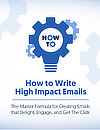
How to Write High Impact Emails
Learn how to write winning emails from one of the best email writers in the industry today. From writing subject lines that get noticed to “call to actions” that get results, it’s all included in this home study program. Learn More »